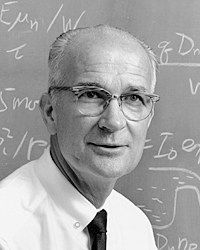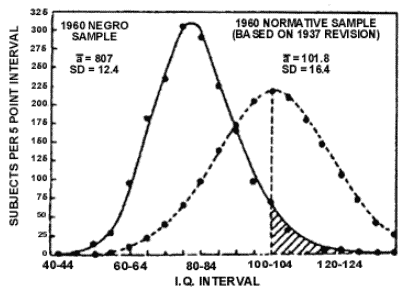William Shockley in His Own Words
Thomas Jackson, American Renaissance, January 1993
William Bradford Shockley was, at the time of his death in 1989, perhaps the most reviled man in America. His public image, created by a relentlessly hostile press, was that of a mad scientist, firmly in the service of evil. His crime was not merely to have publicized unacceptable views on race, intelligence, and genetics, but to have lent them the prestige of a Nobel laureate in physics.

William B. Shockley
Shockley on Eugenics and Race, edited by Dr. Roger Pearson, is a collection of Dr. Shockley’s papers written from 1965 to 1975. This was the very decade during which leftist-egalitarian thinking was tightening its grip on the country. It is hazardous enough today to preach heresy on the subject of race and intelligence, but to have done so when Dr. Shockley was most active was to court assassination.
It was only due to Dr. Shockley’s prominence as a scientist that he was able to get a hearing at all. After receiving his Nobel prize in 1956 for leading the team that invented the transistor, Dr. Shockley founded one of the first high-technology companies in Silicon Valley and was appointed a professor at Stanford University. When, in 1965, he began to preach eugenic heresies, his views hit the country like a bomb.
The Future of Man
Dr. Shockley’s main concerns can be quickly summarized. The best available evidence suggested to him that mankind faced a serious dysgenic threat. The least intelligent were reproducing much more quickly than the most intelligent, and this backward evolution threatened the very basis of civilization. Even more provocative was his view that blacks were devolving more rapidly than whites, since low-IQ blacks were outbreeding high-IQ blacks more rapidly than low-IQ whites were outbreeding high-IQ whites. Furthermore, since blacks were devolving from a lower average IQ to begin with, they faced the prospect of serious, permanent degeneration.
It is important to note that Dr. Shockley never claimed that he had proven that any of this was happening. All he asked was that the nation seriously investigate questions of heredity, intelligence and demographic trends. If Dr. Shockley were proven right then the nation could decide what should be done. If he were shown to be wrong, he would offer a graceful retraction.
The forum in which Dr. Shockley most vigorously pressed his case for research was the National Academy of Sciences (NAS). As a member of the Academy he had the right to propose research projects and he did so every year from 1967 to 1972. Some of the most interesting papers in this collection are proposals to the NAS.
It is not hard to imagine the reception they received. As Prof. Arthur Jensen of the University of California at Berkeley points out in his preface to this book, Dr. Shockley was not a diplomat. Both in speech and in writing his aim was precision, rather than what we today call “sensitivity.”
In his second research proposal to the Academy he urged it to “inquire into ways to determine how many probable misfits regardless of race will be born into our potentially great society as a result of present population patterns.” In the same proposal he tackled the race question head-on, pointing out that to blame all the failures of black people on racism was a misdiagnosis of the problem. “I sincerely and thoughtfully believe,” he wrote, “that my current attempts to demonstrate that American Negro shortcomings are preponderantly hereditary is the action most likely to reduce Negro agony in the future.” In other words, if dysgenics were the problem, it could be solved through eugenics.
This sort of thing was much too racy for the NAS and it turned down Dr. Shockley’s proposals year after year. Eventually, the great physicist lost patience. He had repeatedly warned the Academy that if differential birth rates really had thrown evolution into reverse, it was a catastrophe that required immediate attention. In his last proposal to the NAS in 1972, he called the Academy’s inaction “the most serious and obvious dereliction of intellectual responsibility in the history of science.”
It is clear from his papers that for Dr. Shockley, it was the sacred duty of scientists to search for the truth no matter how painful the truth might be. He often told his fellow scientists that “the courage to doubt in the face of the desire to believe is the true mark of the scientist” and reminded them of the moral obligation to think. Many of Dr. Shockley’s colleagues did think, and privately encouraged him, but only a few were willing to lend him public support.
As Dr. Pearson points out in his introduction to this collection, Dr. Shockley knew that research of the kind he thought vital to the nation’s future would never be possible if the media persisted in calling it “fascist” and “Nazi.” As he found himself spending more and more time fending off charges of “racism,” he began blaming “inverted liberals” who supported “unsearch” rather than research. He feared that those who thought they were helping blacks by opposing race-related research were the worst culprits. “If such effects [dysgenic trends among blacks] are occurring and if entrenched dogmatism is blocking their discovery,” he wrote, “then the consequence may be a cruel form of genetic enslavement. . . .”
Thought Experiments
Dr. Shockley never made formal policy proposals, but some of the “thought experiments” he suggested in his papers come very close. The best known was the $1,000 Bonus Proposal. Anyone of childbearing age would be offered $1,000 for every IQ point under 100 if he agreed to be sterilized. Dr. Shockley even suggested that for people too stupid to learn about the bonus, “bounty hunters” could be rewarded for calling it to their attention.
The Deci-Child Certificate Plan is less well known. First, all women would be made sterile at an early age by contraceptive implant. At the same time, each woman would be issued a number of deci-child certificates, according to the average number of children society had determined would be best for the country. If that number were 2.2 per woman, then all women would be issued 22 deci-child certificates.
A married woman would be able to turn in ten certificates to have the implant removed for long enough to have one child. She could turn in ten more if she wanted another child. Women who did not want to have children could sell their certificates on the open market, so if a woman wanted five children she would have to buy extra certificates. If a woman were sure she was going to be a nun she could sell her certificates as soon as they were issued. Dr. Shockley thought that under such a plan only people who wanted and could afford them would have children.
The Scientific Mind
The papers in this book were not written for publication in a single volume so they sometimes cover the same ground. This can be irritating, but it does highlight the ideas that Dr. Shockley himself thought vital.
At the same time, one of the most edifying aspects of reading these papers is to see how a man with a rigorously scientific mind approached subjects that are usually governed by pure emotion. Often he stated the reasons for his views as a series of postulates, and whenever he took a position he gave clear reasons for it. But even when he was not being explicitly scientific, his formulations were often much more provocative than anything ordinarily found in the social sciences.
“Nature,” he wrote, “has color-coded groups of individuals so that statistically reliable predictions of their adaptability to intellectually rewarding and effective lives can easily be made and profitably be used by the pragmatic man-in-the-street.” In other words, judgments based on race are meaningful, and it would be foolish not to make them.
On eugenics, he wrote: “To me, it seems immoral not to view with concern, and perhaps not to try to prevent the birth of human beings . . . forced by the improvidence of their mothers and the obtuseness of society to emerge into the world . . . so disadvantaged by an unfair shake from a badly loaded parental genetic dice cup.”

Finally, even though he was an atheist, Dr. Shockley had a conception of the purpose of life that he recommended to believers and agnostics as well: “During the last rational five minutes of my life, . . . I hope to consider that by demanding objective inquiry and open discussion of human quality problems I have used my capacities in keeping with the objective . . . of conferring greatest benefit on humanity.”
Dr. Shockley believed that his eugenics work was much more important than the discovery of the transistor. As he explained, without a certain level of human intelligence, there could be no transistors or much else, for that matter. This collection of Dr. Shockley’s papers gives us more than enough to conclude that his last five rational minutes were probably just as he had hoped they would be.















